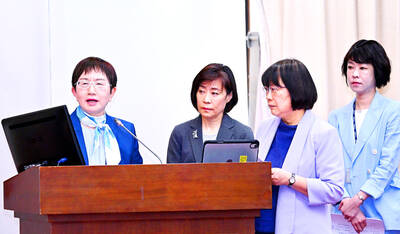The Chung-Hua Institution for Economic Research (CIER, 中華經濟研究院) yesterday revised downward its forecast for GDP growth this year to 4.29 percent from the 4.55 percent it forecast in December, citing the impact from Japan’s massive earthquake and tsunami.
“The nation’s economic growth this year will be negatively affected by Japan’s earthquake, especially in the second quarter,” Wang Lee-rong (王儷容), director of the institute’s center for economic forecasting, told a media briefing.
The Taipei-based think tank expected GDP growth to rise 3.94 percent in the second quarter and 4.49 percent in the second half of the year because of a lower base and strong exports, Wang said.
The institute’s research model was based on the IHS Global Insight’s latest forecast, which revised Japan’s GDP growth downward to zero this year from 1.1 percent growth, CIER researcher Peng Su-ling (彭素玲) said.
As a result of this change, the institute cut its GDP forecast for Taiwan by 0.31 percentage points, Peng said.
Taiwan’s GDP growth could drop even lower if the Japanese economy falls further in the wake of the radioactive disaster and ensuing power shortage, Wang said.
“At the most, Taiwan’s GDP growth could decrease by 0.64 percentage points for this year, on the assumption that Japan’s full-year GDP contracts by 1.5 percent,” Wang said.
Although researchers generally thought the Japanese quake would only have a limited impact on the global economy, Su Hsien-yang (蘇顯揚), director of the institute’s Japan center, said the Taiwanese economy would be more affected because of the close connection to Japan’s supply chain.
Taiwan should grab the opportunity to learn more high-level skills from Japan, as it plans to deepen its cooperation with other countries after the quake, Su said.
As to Standard & Poor’s negative outlook on US government debt, Wang said this could also have a negative impact on Taiwan’s GDP growth, but it was too early to provide estimates.
The institute expected Taiwan’s full-year inflation to grow at a steady 1.78 percent, while the wholesale price index could increase 3.35 percent this year.

‘SWASTICAR’: Tesla CEO Elon Musk’s close association with Donald Trump has prompted opponents to brand him a ‘Nazi’ and resulted in a dramatic drop in sales Demonstrators descended on Tesla Inc dealerships across the US, and in Europe and Canada on Saturday to protest company chief Elon Musk, who has amassed extraordinary power as a top adviser to US President Donald Trump. Waving signs with messages such as “Musk is stealing our money” and “Reclaim our country,” the protests largely took place peacefully following fiery episodes of vandalism on Tesla vehicles, dealerships and other facilities in recent weeks that US officials have denounced as terrorism. Hundreds rallied on Saturday outside the Tesla dealership in Manhattan. Some blasted Musk, the world’s richest man, while others demanded the shuttering of his

ADVERSARIES: The new list includes 11 entities in China and one in Taiwan, which is a local branch of Chinese cloud computing firm Inspur Group The US added dozens of entities to a trade blacklist on Tuesday, the US Department of Commerce said, in part to disrupt Beijing’s artificial intelligence (AI) and advanced computing capabilities. The action affects 80 entities from countries including China, the United Arab Emirates and Iran, with the commerce department citing their “activities contrary to US national security and foreign policy.” Those added to the “entity list” are restricted from obtaining US items and technologies without government authorization. “We will not allow adversaries to exploit American technology to bolster their own militaries and threaten American lives,” US Secretary of Commerce Howard Lutnick said. The entities

Minister of Finance Chuang Tsui-yun (莊翠雲) yesterday told lawmakers that she “would not speculate,” but a “response plan” has been prepared in case Taiwan is targeted by US President Donald Trump’s reciprocal tariffs, which are to be announced on Wednesday next week. The Trump administration, including US Secretary of the Treasury Scott Bessent, has said that much of the proposed reciprocal tariffs would focus on the 15 countries that have the highest trade surpluses with the US. Bessent has referred to those countries as the “dirty 15,” but has not named them. Last year, Taiwan’s US$73.9 billion trade surplus with the US

Prices of gasoline and diesel products at domestic gas stations are to fall NT$0.2 and NT$0.1 per liter respectively this week, even though international crude oil prices rose last week, CPC Corp, Taiwan (台灣中油) and Formosa Petrochemical Corp (台塑石化) said yesterday. International crude oil prices continued rising last week, as the US Energy Information Administration reported a larger-than-expected drop in US commercial crude oil inventories, CPC said in a statement. Based on the company’s floating oil price formula, the cost of crude oil rose 2.38 percent last week from a week earlier, it said. News that US President Donald Trump plans a “secondary